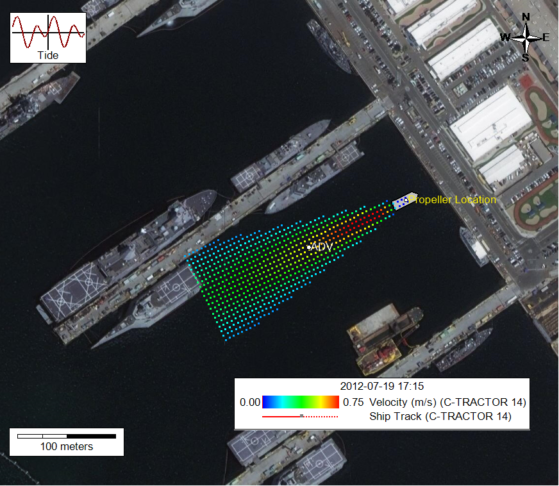
Sediment resuspension occurs in harbors across the world as a function of propeller-induced water velocities, and resulting shear stress, at the sediment-water interface. While such events occur with great frequency and are generally not remarkable, the potential effects of propeller-induced velocities (propeller wash or propwash) on the erosion, transport, and re-deposition of contaminated sediments can be significant (e.g. San Diego Harbor, Gowanus Canal, Newtown Creek, Lower Duwamish River, and Portland Harbor Superfund sites). Over the years, several approaches have been presented to compute the effect of the propwash linked to a numerical sediment transport model [e.g. Maynord (2008), Chadwick, et al. 2008, and Wang et al. (2016)]. These approaches have limitations that usually prevent full dynamic coupling to sediment transport models and/or chemical fate and transport models. Frequently, they are limited to steady state conditions and single types of vessels. Most of these models are decoupled, i.e. the propwash resuspension is separately computed then manually added as a source term to the far-field model for sediment transport analysis (Chadwick, et al. 2008).

Through a research collaboration with the United States Navy NIWC and ExxonMobil, DSI is using observations of ship-induced re-suspension from selected harbors in the U.S. to develop an integrated propeller wash sub-module for the EFDC+ Explorer Modeling System (EEMS). This system can utilize the automated information system (AIS) telemetry from vessels regarding their position and orientation every few minutes or any user defined ship track information. As the ship(s) move, a Lagrangian propwash velocity/erosion field tracks with each ship and the erosion fluxes are integrated into the larger scale hydrodynamic model grid. To appropriately simulate the flow field induced by a rotating propeller, a general solution for flow velocities based on the physical parameters of the vessel and propeller(s) is computed. Several propwash approaches (Maynord 1990, Maynord 2000, Lam, et al. 2011, Hamill & Kee 2016 and Jiang, et al., 2019) were evaluated using datasets collected by NIWC (Wang, et al., 2016) and other researchers. The propwash computation approach used a blend of Hamill and Maynord to accommodate the specification of applied power (i.e. propeller revolutions or horsepower).
While these features are still in development, DSI hopes to release the fully integrated propwash module for EEMS in the next 6 months. The introduction of this feature will represent a tremendous step forward in the ability of remediation teams at contaminated sediment sites to properly consider the role of propwash in their evaluations and designs.
Interested in giving EEMS a try? You can learn how to build your own models today using our free demo, or download a demonstration model to get started.
Want to give EEMS a try with propwash? You can start by downloading EEMS and activating in the free demo mode and the running our demonstration model. To see these features in action, head over to our YouTube page.
References
Chadwick D. B., G. Rosen , P. F. Wang (SSC Pacific), R. C. Santore , A. C. Ryan , P. R. Paquin , S. D. Hafner (Hydroqual Inc) , W. Choi (San Diego State University). Demonstration of an Integrated Compliance Model for Predicting Copper Fate and Effects (2008) in DoD Harbors. Environmental Security Technology Certificate Program (ESTCP) Project ER-0523. Technical Report 1973
Hamill, G.A., and C. Kee, Predicting axial velocity profiles within a diffusing marine propeller jet, Ocean Engineering, 124, 104-112, 2016.
Jinxin Jang, Wei-Haur Lam, Yonggang Cui, Tainming Zhang, Chong Sun, Jianhua Guo, Yanbo Ma, Shuguang Wang, Gerard Hamill, Ship twin-propeller jet model used to predict the initial velocity and velocity distribution within diffusing jet. School of Natural and Built Environment, KSCE Journal of Civil Engineering, Mar 2019
Lam, W-H., et al. A review of the equations used to predict the velocity distribution within a ship’s propeller jet. Ocean Engineering 38.1 (2011): 1-10.
Maynord, S. T. Velocities induced by commercial navigation. No. WES/TR/HL-90-15. Army Engineer Waterways Experiment Station Vicksburg MS Hydraulics Lab, 1990.
Maynord, S.T. Physical forces near commercial tows. Interim report for the Upper Mississippi River – Illinois Waterway System Navigation Study, USACE, 2000
Wang, Pei-Fang, Ignacio Rivera-Duarte, and Ken Richter. Evaluation of Resuspension from Propeller Wash in DoD Harbors. No. SSC-TR 3049. Space and Naval Warfare Systems Center Pacific San Diego United States, 2016.

